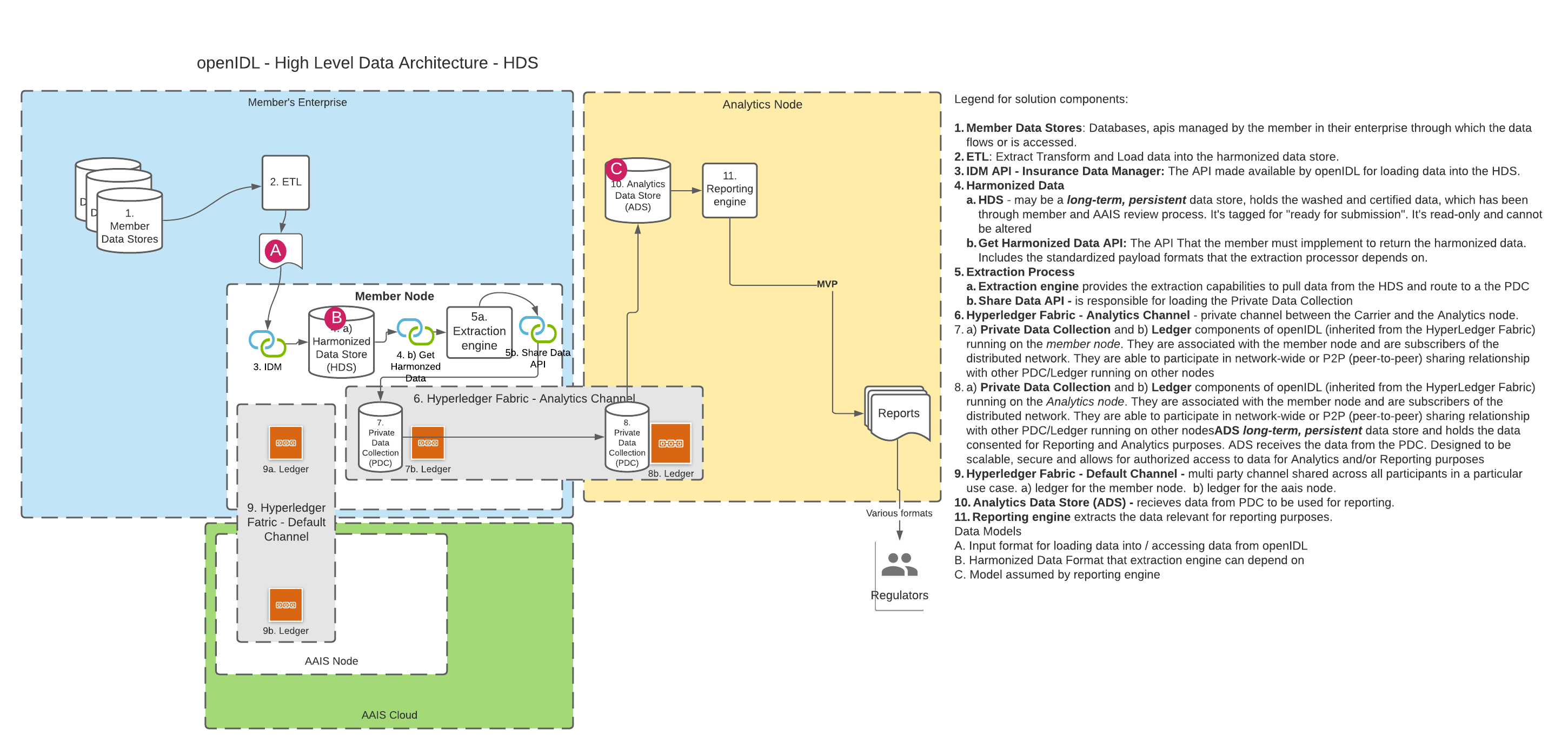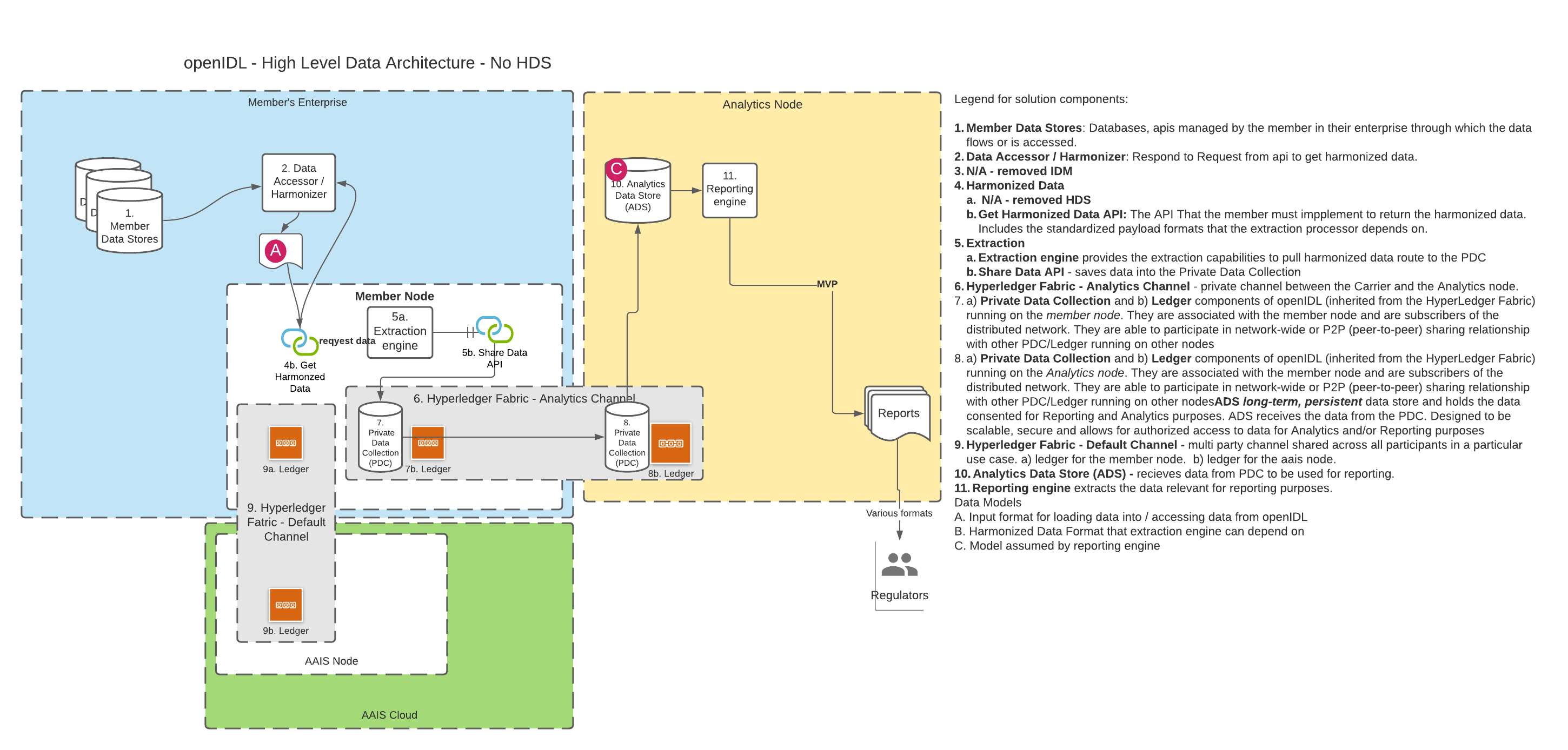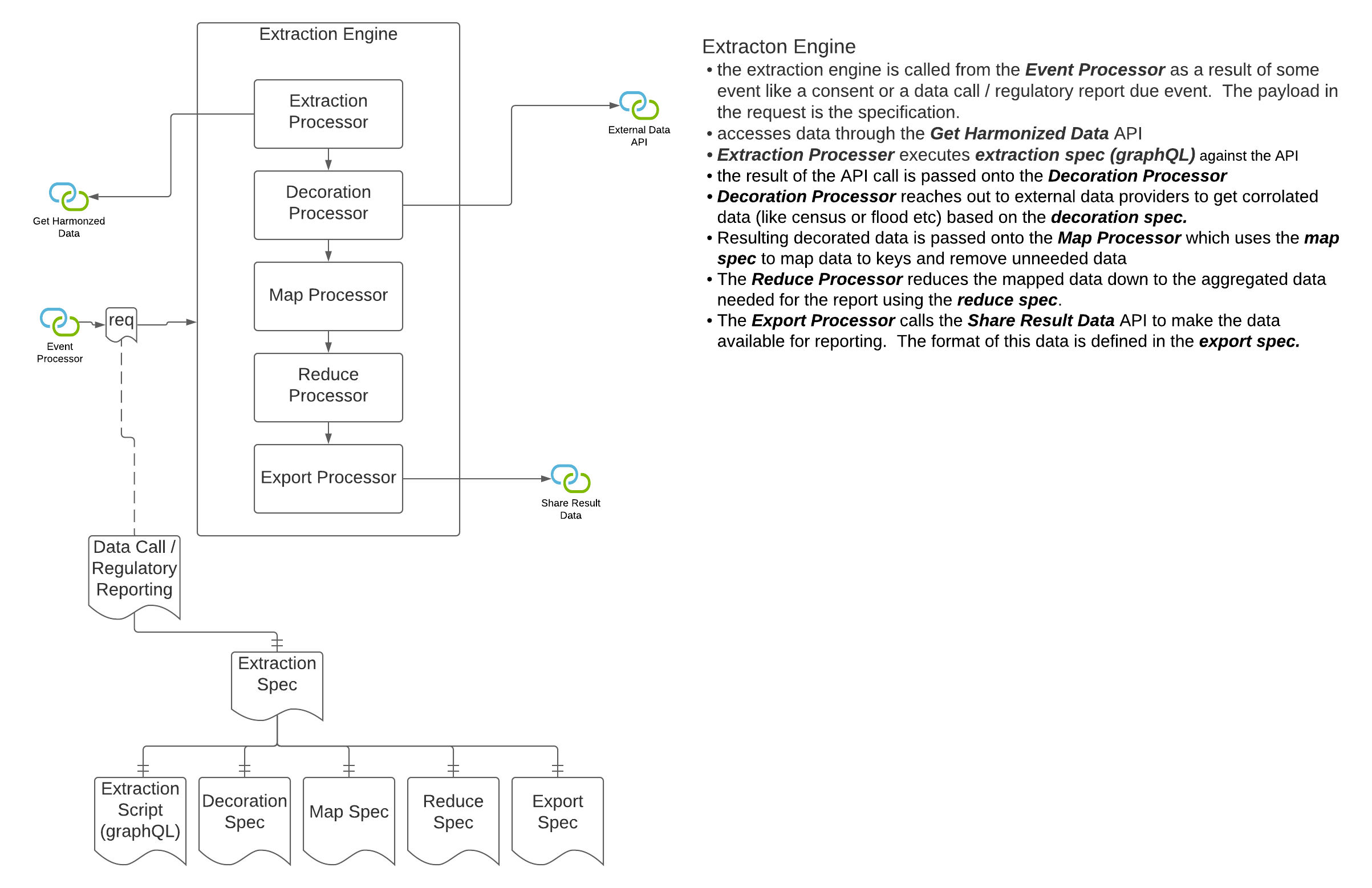openIDL Navigation
This page describes the decisions we have taken and the tenets that drive them.
Table of Contents
Architecture Tenets
Here we discuss the tenets of the architecture. Which things are most important and why. When we make architecture decisions below, they take these tenants into account.
The System Must be Manageable
We will have a distributed network using distributed ledger technology in the guise of Hyperledger Fabric. The surrounding components such as APIs, UI Applications, Databases, Extraction Patterns and Data Transformation and Enrichment must all be managed. That is, when we have the need to add some new functionality, we want all the participants to have the necessary components. To make this work, the node must be manageable. For this purpose we intend to use GitOps, where the configuration is managed by a configuration held in git which is used to update the node components automatically.
The System Must be Cloud Agnostic Whenever Possible
The openIDL components will most often be deployed to the cloud. While we will use AWS, other participants may choose another cloud provider. For this reason, we want the deployment to work in any one of the possible clouds without undo alteration or duplication. There will be specific areas where the cloud provided services must differ. In these cases, we will use a layer to normalize the interface if possible. We must always be careful to balance cost and complexity with flexibility.
Infrastructure as a Service before Self Managed Infrastructure
Whenever possible when there is a choice between implementing infrastructure that we manage and that which is managed automatically by the cloud provider, lean toward cloud provider managed solutions.
The System Must be Transparent
The use of Infrastructure as Code will make the system’s configuration self documenting. Anywhere this does not fully explain, extra documentation must be provided. This is generally found in the README.md files in git.
The Privacy of the Data Distributed Nodes is Paramount
The data made available to the openIDL system must have privacy managed by the data owner. The owner must control all "access" to the data and be confident that no data is shared with other nodes without their knowledge.
Architecture Decisions
SECURITY
SUBJECT | Secret Management |
|---|---|
| STATUS | Open |
DECISION | The secrets are held in: GitHub Secrets and Vault The secrets are managed by: The secrets are accessed from Iac …? |
DISCUSSION | The management of secrets is complicated. Below are some requirements for the solution. If we can tick off all these, we’ll have a winner. Must be able to manage: - carrier secrets - api keys - aais secrets - common secrets - cloud provider secrets - database secrets - hlf network secrets like certs - application secrets - distributed secrets Must: - rotate passwords - be encrypted - permissioned so only visible to specific individuals or ci/cd - manageable - update / delete / create / view - auditable - know what changed and that no breaches have occurred - be accessible from IaC - terraform - be accessible from IaC - helm - be accessible during CI/CD - be cloud agnostic for use - be multi-cloud - have a health check of the system - at startup and intervals - provide logging and notifications of updates - exhibit CIA - confidentiality, integrity, access - have a user interface for managing the secrets Options: - tools o vault o aws secrets manager - |
SUBJECT | Automation of Hyperleger Fabric Network Setup |
|---|---|
| STATUS | Open |
DECISION | Use Blockchain Automation Framework (BAF) |
DISCUSSION | BAF will be used to set up the network automatically. BAF will run on a pod inside the kubernetes cluster so it has access to the required credentials and certificates that are stored in Vault. The Vault instance is running inside the private cloud, so the automation cannot run from GitHub actions. |
| SUBJECT | User Authentication for Application Access |
|---|---|
| STATUS | Open |
DECISION | User Authentication is Platform Specific or can it use Okta |
DISCUSSION | The authentication of users must be cloud specific for access to applications because there is no generic authentication provider. - start with aws strategy - cognito - want to offload identiy to identity provider - can we use okta as the main identity management and link it to the underlying provider thus acting as a common api for the applications? |
DATA ARCHITECTURE
A. Using the HDS DB
B. Using only the API
| SUBJECT | DA - Extraction Processing |
|---|---|
| STATUS | Open |
DECISION | TBD |
DISCUSSION | In openIDL when a data call (or a stat reporting) is "consented to" by the carrier, the data must first be accessed from somewhere and then transformed into the result format and lastly converted into a report that the target party (usually a regulator) can access or be sent. The transformation of the data from its "harmonized" state to the result state is called the "extraction", "extraction pattern" or "extraction process". Since accessing the data can take multiple forms (see other architecture decision "Harmonized Data", there is some variability in this decision while that decision is undecided. We can assume that the data being accessed for the extraction is "harmonized", meaning for every execution of the extraction on a single node or multiple nodes for a single carrier or multiple carrier, the schema and semantics of the data are known and consistent. Creation and Management of extractions can be organization. For stat reporting, this is the stat-agent (such as AAIS), for data calls, it could be the regulator or a representative like the stat-agent. In either option from the diagrams above, the extraction processor will access the data through an api instead of accessing a database directly. It is proposed that graphQL be considered as the language used to access for extraction and summarization. The extraction processor could apply some correlation to the data, like using an address to look up census data or similar. This means the extraction is more than just a data access. |
| SUBJECT | DA - Harmonized Data Scope |
|---|---|
| STATUS | Proposed |
DECISION | Proposal: data format / schema will be standardized across nodes, for a given use case |
DISCUSSION | The data available for extraction must be normalized for multiple extractions across multiple use cases across multiple members. Is this one single model? Is the data at rest in the same model as the data in motion? |
| SUBJECT | DA - Harmonized Data Loading / Normalization |
|---|---|
| STATUS | Proposed |
DECISION | Proposal: If the HDS is at rest, the loading of that data is the responsibility of the member owner of the node. If the HDS is an API, the maintenance of that API is the responsibility of the Technical Steering Committee and the mapping to other data sources is the responsibility of the member owner of the node. |
DISCUSSION |
|
| SUBJECT | DA - Harmonized Data Format Governance |
|---|---|
| STATUS | Proposed |
DECISION | Proposal: data schema, enumeration and the data dictionary will be standardized, and endorsed by the RRSC (and other groups per use case) |
DISCUSSION | The Technical Steering Committee, Regulatory Reporting Steering Committee and the Data Model Steering Committee are all possible owners of this. |
| SUBJECT | DA - Harmonized Data Store |
|---|---|
| STATUS | Proposed |
DECISION | Proposal:
|
DISCUSSION | The data available for extraction must be normalized for multiple extractions across multiple use cases across multiple members. Is this one single model? Is this one database? Is this data at rest and/or available through an API |
| SUBJECT | DA - Harmonized Data Access |
|---|---|
| STATUS | Proposed |
DECISION | Proposal:
|
DISCUSSION | If we determine that a standing harmonized store is not required, then we must establish an API with a standardized payload format that can be used to access the data. The member must "certify" that the data is available and quality in order to consent to a data extraction. The consent and certification can be captured on the ledger. The call to the API will come from the extraction processor. The extraction processor can run on the member node. Can the extraction processor run on the Analytics Node? If the extraction runs outside the member node, how does this work? Can it call the API directly? Must we use HLF to "transport" the data? |
| SUBJECT | DA - Harmonized Datastore DBMS Implementation |
|---|---|
| STATUS | Open |
DECISION | Proposal: HDS will be a relational database. It cannot be a noSQL, graph, document DB etc. technical implementation of a HDS is non-prescriptive i.e. it can be MySQL, MS SQL, Oracle etc. |
DISCUSSION | If data is at rest in the harmonized datastore, what is the technology? Does it need to be a single dbms? Should it be noSQL? Can it just be an interface? |
| SUBJECT | DA - Harmonized Data Model |
|---|---|
| STATUS | Open |
DECISION | ?? |
DISCUSSION | The data available for extraction must be normalized for multiple extractions across multiple use cases across multiple carriers. The data must be produced by the carrier from their original sources. Is this an ETL process? What is the format of the load data? Is it the schema of a standing HDS database or is it a messaging format? Is there just one "in transit" model or are there different ones for different contexts? Contexts might be the data call, the line of business, etc. |
APPLICATION DEVELOPMENT
| SUBJECT | Common UI Code Management |
|---|---|
| STATUS | Open |
DECISION | Single Application Angular UI Variations will utilize angular libraries |
DISCUSSION | The library will be a different kind of angular app located in the same super library as all apps that use it. This is the approach for the data-call-ui. (openidl-ui and openidl-carrier-ui) For common / shared libraries we will use an npm registry. |
DEV / OPS
| SUBJECT | Local Kubernetes Development |
|---|---|
| STATUS | Open |
DECISION | Use Minikube for Local Kubernetes Runtime |
DISCUSSION | There are multiple options for local kubernetes deployment. We chose Minikube over Kind because of it's simplicity. |
| SUBJECT | Infrastructure as Code |
|---|---|
| STATUS | Open |
DECISION | Use a combination of solutions depending on application.
|
DISCUSSION | Provide options for selection upon setup.
All provisioning artifacts are managed in git The customer will have a github / gitlab account that is private to them. We may or may not have access to that repository. To accept updates, the customer will accept a merge/pull request into their repository with our changes. That update in git will automatically trigger the workflow. The workflow may allow automatic provisioning or require an acceptance from the customer. - milestones
target will have two options for node owners
|
| SUBJECT | Infrastructure as Code |
|---|---|
| STATUS | Open |
DECISION | Use Terraform to provision cloud specific services |
DISCUSSION |
| SUBJECT | Infrastructure as Code |
|---|---|
| STATUS | Open |
DECISION | Execute Terraform using GitHub actions |
DISCUSSION | If possible use GitHub actions - see above for options |
| SUBJECT | Infrastructure as Code |
|---|---|
| STATUS | Open |
DECISION | Use Flux v2 for Deployment of Kubernetes artifacts |
DISCUSSION | This technology enables GitOps in build and deployment |
| SUBJECT | Infrastructure as Code |
|---|---|
| STATUS | Open |
DECISION | Use Helm Charts for Application and Network provisioning in Kubernetes |
DISCUSSION | Helm is a very popular way to provision Kubernetes clusters |
| SUBJECT | DevOps |
|---|---|
| STATUS | Open |
DECISION | Publish Common Libs as images to NPM Registry in GitHub |
DISCUSSION | Any common components should be packaged as images and published to the GitHub packages. |
| SUBJECT | DevOps |
|---|---|
| STATUS | Open |
DECISION | Images should be published in the GitHub packages container registry |
DISCUSSION | Since we separate building of images from their deployment, we can build the images into the registry and then refer to that registry when deploying |
| SUBJECT | Secrets Management |
|---|---|
| STATUS | Open |
DECISION | secret management should be cloud agnostic |
DISCUSSION | Notes |
| SUBJECT | Secret Management |
|---|---|
| STATUS | Open |
DECISION | Secrets are applied during deployment, not in the image |
DISCUSSION | The images used to create the pods in Kubernetes should not contain any private information. This can all be applied during deployment by mounting the file from a secret held outside. |
| SUBJECT | MongoDB |
|---|---|
| STATUS | Open |
DECISION | The Harmonized Data Store will be deployed inside kubernetes |
DISCUSSION | The best practice regarding databases and Kubernetes is to host them outside. As long as the db is mongo and has a uri accessible to the insurance data manager and other apis, it is viable. The terraform to set it up may need different flavors for the different clouds. |
| SUBJECT | UI Deployment | ||||||||||||||||||||||||
|---|---|---|---|---|---|---|---|---|---|---|---|---|---|---|---|---|---|---|---|---|---|---|---|---|---|
| STATUS | Open | ||||||||||||||||||||||||
DECISION | The UI will be deployed inside kubernetes | ||||||||||||||||||||||||
DISCUSSION | There are two main choices for deploying the ui. Here is the discussion about the relative merits for the options.
We deploy the applications inside kubernetes so they are more manageable. This includes the APIs and the UIs. Deploying at the edge is a best practice, but manageability is more important in this case. We can deliver updates to the code as images in a container registry and have them deployed much easier than if we used AWS (or other cloud) specific services. Q: Why not have a centralized UI? A: The UI is configured to access the API. iI has to have private access to the API inside the node, not go out onto the internet and have the apis exposed publicly. The apis are private to the member cloud, actually private to the kubernetes cluster. Because manageability is a very high priority item for the ui components, this outweighs the differences in other aspects. |
| SUBJECT | Channel Policy |
|---|---|
| STATUS | Open |
DECISION | The Channel Policy will be set to ANY with a specific role required to allow new organizations to join the network |
DISCUSSION | The channel policy controls how new organizations are joined to the network. If set to Majority, many of the participants on the network must approve new organizations. If set to Any, then just one is required. We will create a role of Admin which will be required by the policy for any organization to approve new organizations. |


